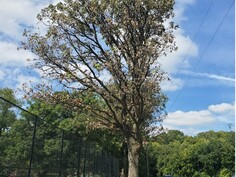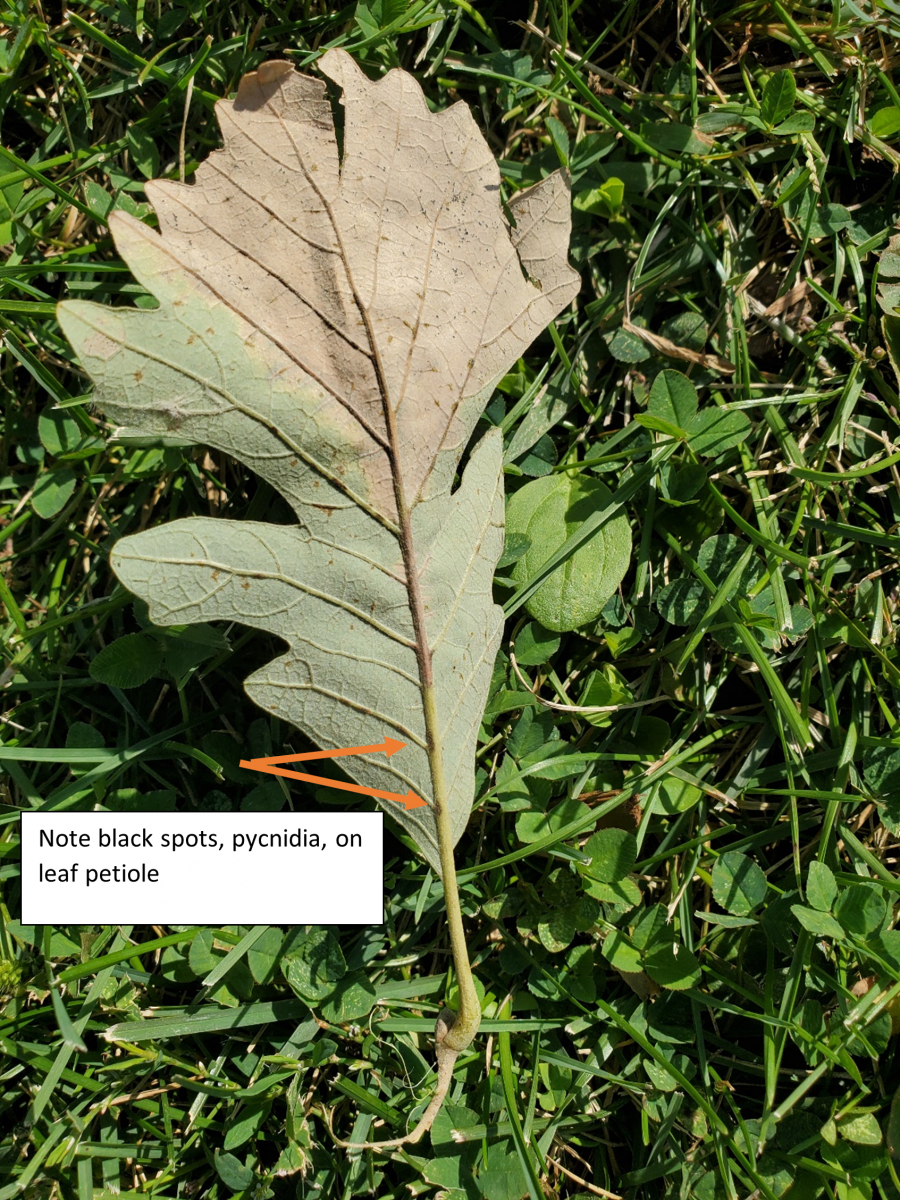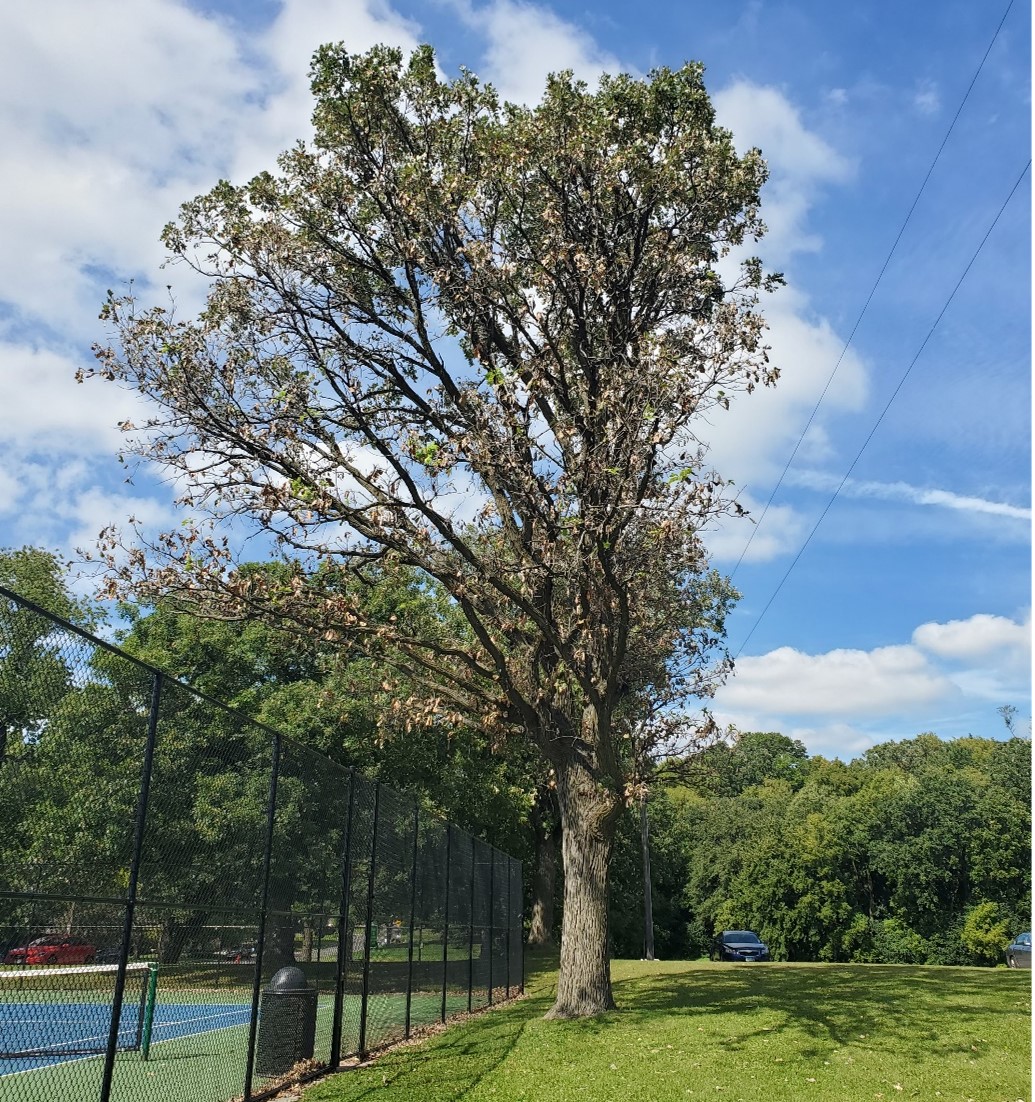Latest News
Give Your Oaks the Benefit of the Doubt

Article submitted by Mark Rehder, Director-Vendor/Contractor, APWA-MN, and owner of Rehder Forestry Consultants
 Most cities receive numerous calls each year with regards to questions on oak trees. One of the more frequent calls received is with regard to Bur Oak Blight, or BOB. Hundred-year oaks and older are being impacted by a very destructive leaf fungus. Fortunately, it only impacts bur oaks, and red and white oaks are not affected. This fungus attacks the leaves of the bur oak tree. Then, it persists on the leaves and twigs as an overwintering spore. As the spring rains arrive, they will agitate these fungal spores that persisted on the leaves and twigs, and these spores will infect new leaves as they emerge. In the picture of the underside of the leaf, these black spores (pycnidia) are clearly visible on the leaf petiole as small black spots. The vein of the leaf is also turning black which ultimately causes wedge-shaped segments between leaf veins. Eventually, the whole leaf turns brown. Symptoms usually are not noticed until July and August and up until that time trees can appear very normal and healthy-looking. That is always why it is such a shock to park managers when they see their beautiful large bur oak tree turning an ugly shade of brown during the growing season. As in the picture, the lower portion of the tree is most severely impacted as this is where moisture levels are the highest, and air movement is the least. Bur oaks can annually lose about 50% of their canopies and remain healthy. Some park managers are getting used to seeing the same tree go through this annual process but how long can the tree handle what is clearly an unhealthy situation. Well, we really do not have a good answer to that question and it probably is specific to the tree. What we do know is that the trees will put out a fresh set of leaves the following spring and that is why it is critical that we do not remove these diseased, not dead trees. Scientists believe the cause of BOB is warmer and wetter springs over the last decade or so which has boosted the occurrence of this pathogen. Strangely enough, not all varieties of bur oaks are impacted, but specifically, bur oaks with smaller acorns that are associated with oak savannas. Often, you will see one bur oak that is severally impacted while the neighboring tree does not seem to be affected at all.
Most cities receive numerous calls each year with regards to questions on oak trees. One of the more frequent calls received is with regard to Bur Oak Blight, or BOB. Hundred-year oaks and older are being impacted by a very destructive leaf fungus. Fortunately, it only impacts bur oaks, and red and white oaks are not affected. This fungus attacks the leaves of the bur oak tree. Then, it persists on the leaves and twigs as an overwintering spore. As the spring rains arrive, they will agitate these fungal spores that persisted on the leaves and twigs, and these spores will infect new leaves as they emerge. In the picture of the underside of the leaf, these black spores (pycnidia) are clearly visible on the leaf petiole as small black spots. The vein of the leaf is also turning black which ultimately causes wedge-shaped segments between leaf veins. Eventually, the whole leaf turns brown. Symptoms usually are not noticed until July and August and up until that time trees can appear very normal and healthy-looking. That is always why it is such a shock to park managers when they see their beautiful large bur oak tree turning an ugly shade of brown during the growing season. As in the picture, the lower portion of the tree is most severely impacted as this is where moisture levels are the highest, and air movement is the least. Bur oaks can annually lose about 50% of their canopies and remain healthy. Some park managers are getting used to seeing the same tree go through this annual process but how long can the tree handle what is clearly an unhealthy situation. Well, we really do not have a good answer to that question and it probably is specific to the tree. What we do know is that the trees will put out a fresh set of leaves the following spring and that is why it is critical that we do not remove these diseased, not dead trees. Scientists believe the cause of BOB is warmer and wetter springs over the last decade or so which has boosted the occurrence of this pathogen. Strangely enough, not all varieties of bur oaks are impacted, but specifically, bur oaks with smaller acorns that are associated with oak savannas. Often, you will see one bur oak that is severally impacted while the neighboring tree does not seem to be affected at all.

So, what can you do, as the caretaker of the trees, to help manage BOB? Besides hoping for a cool, dry spring, there are a few things that you can do. If the trees are of high value, you can have a city-licensed tree care company treat the trees with a fungicide. However, the treatment needs to be done in the spring, as leaves are emerging. This should limit the amount of inoculum on the leaves and result in significantly less leaf browning, helping the tree in the short term to fend off secondary invaders that take advantage of stressed trees. After treatment, do not treat again until the tree has lost roughly 40 percent of its leaves to bur oak blight for two years in a row. Because bur oak blight is a native disease made worse by wet springs and summers, it is not possible to control levels of the pathogen.
To help ensure the health and vigor of all trees, watering, mulching, and proper pruning are all important steps a park manager can take. Trees need approximately one gallon of water per every inch of DBH (diameter at breast height) per week. Mulching helps maintain a more consistent, cooler soil temperature and even moisture. Proper pruning helps remove dead, damaged, and diseased branches as well as allows for more air movement in a tree canopy.
What's New
-

Young Professionals Spotlight
March 25, 2024
-

APWA-MN Education Programs
March 25, 2024
-
Apply for the Young Professionals Stipend: Attend PWX Atlanta
February 23, 2024



